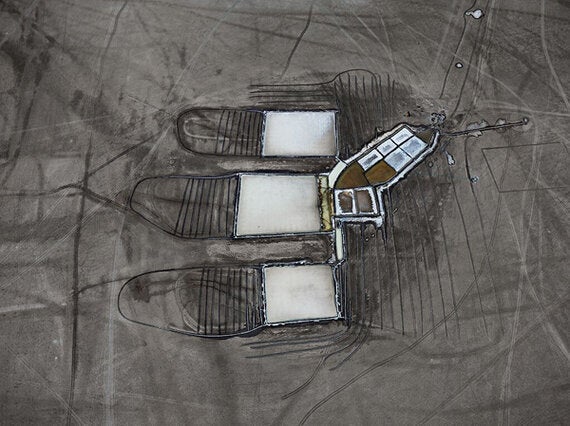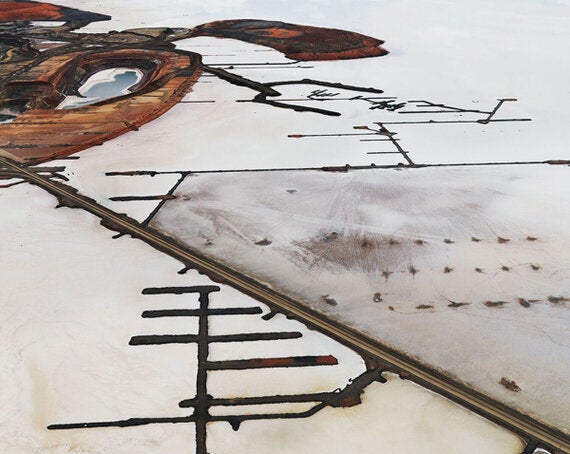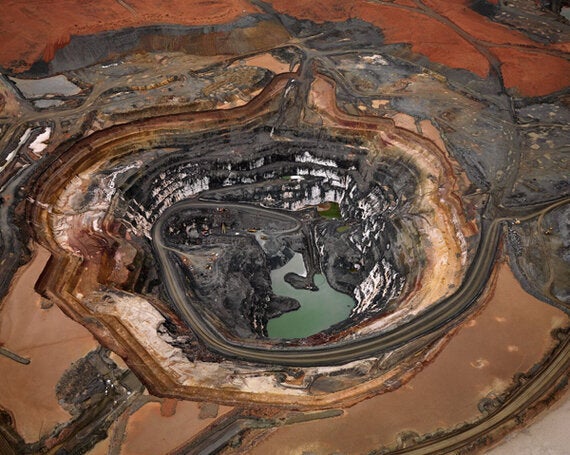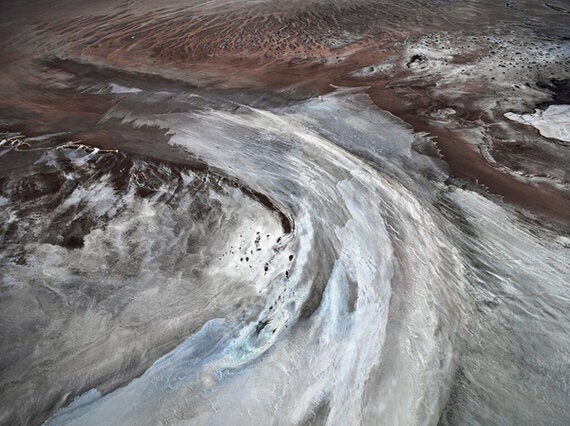Canadian photographer Edward Burtynsky has earned a worldwide reputation for his spectacular, large-form aerial pictures that depict the impact man has made on our natural and urban landscapes around the world.
His high-form Hasselblad lens captures mines, quarries, fields and factories in which man has clawed away at the earth, plundering it to sate our ever-increasing appetite for consumption. Yet, with a an artistic eye inspired by modernist and abstract expressionist painters, he has succeeded in elevating dystopia into something quite beautiful and eye-catching.

This is evident in his series Salt Pans, his latest project being exhibited at London's Flowers Gallery of which Salt Pans no.27 (above) is a prime example. The pictures are taken above The Little Rann of Kutch in Gujarat, India, home to 100,000 salt workers who extract a million tonnes of salt from the floodwaters of the nearby Arabian Sea. Receding groundwater levels and declining market values mean the salt pans are likely soon to disappear.
While this series occupies the downstairs of the Flowers Gallery, the upstairs is devoted to a retrospective of some of 61-year-old Burtynsky's work taken over past decades entitled Essential Elements. Here, I caught up with the artist who began by telling me how he first began seeing landscapes in a non-traditional way.
"What I felt that that pristine landscape lacked was that it was a kind of nostalgia, that I was being drawn into a kind of gravitational force of cliché and genre, calendar work almost. So I started thinking how do I get true to my time. Then I stumbled across a coal mining area in Pennsylvania and suddenly I'd started taking pictures of it thinking that this is another way of looking at landscape, the landscape that we've changed. With this particular area I was on a high hill and in every direction as far as my eye could see the landscape had been disfigured. I found these more interesting than the pristine landscapes I'd shot. They were more in keeping with the world I live in."
So, do you see your work in any way as part of a campaign to further the environmentalist cause?
"I'm loath to say these images are a clarion call for change. I find if you fix the meaning of an image too permanently then it takes the life out of it. It takes away its ability to have a multi-dimensional meaning to it. So I don't want the work to be seen in this way. As a species we need to take things from nature. It's too simplistic to think we cannot. To me it's about our relationship to the natural world and the way in which we go to the natural world to take the things that we need. With the internal combustion engine and with the industrial revolution that taking has hit a scale that's unprecedented, that is now having planetary effects. So I'm interested in being the mediator between those landscapes and our urban existence - that they're interdependent."

This work, Silver Lake 16 (above) again has a feeling of abstract art about it.
"I have been certainly influenced by Abstract Expressionists in that surface and "all-overness", flattening of space and so on. This is where my aerial work began in earnest. This is mining in Western Australia near a place called Kalgoorlie. These are salt lakes and the mines are just underneath. The red earth comes from the high iron content in the soil. Here they're mining mostly silver. You see a road and elsewhere you see all these dumping areas where they're dumping spill and overburden. To me it was the patterns that were so fascinating. These landscapes aren't intended to be aesthetic, they're utilitarian, they're dealing with the problem of having too much material, so we dump it on these roads and you end up making these patterns."

Many of your pictures (like Silver Lake Operations no.1 above) show how we are disfiguring our landscapes yet they have this aesthetic quality. How do you balance that?
"If you hike in a forest, especially in the Fall when all the leaves are down, you have a complex detailed environment rich with layers of information, structure and texture and all those things. I used to walk through that and keep watching it until all of a sudden there's this one spot where it all comes together where it's no longer this random chaos but actually an interesting image and I think that kind of training my eye to work in chaos and finding out when things snap together and wait for the light and get all the other things right is how I work. I've always been interested in taking the idea and then putting it through that rigorous visual process."

This picture, Colorado River Delta 14 (above) has an almost ethereal quality to it.
"I'm always interested in finding landscapes where there's a human element to it. Here there aren't a lot of man-made signs like industry or anything like that. But what's man-made is that it used to be a delta with freshwater. There's a thousand square kilometres of land that's now been turned into a desert. The Colorado River hasn't made it to the ocean for forty years. The ocean tides come up and go back and as it does it leaves this kind of translucent patina that's salt. What I think one of the most powerful things photography does is that it's a conveyor of information through time. I don't want the content to be the driver of the image... I want the form to give reason for its existence. So when I make a picture, for me as an artist I'm saying if I've got it right it feels like it always should have been a picture."
Edward Burtynsky: Salt Pans and Essential Elements is at the Flowers Gallery, 82 Kingsland Road, London E2 8DP until 29 October.
All images are used courtesy of Edward Burtynsky, the Flowers Gallery, London and the Nicholas Metivier Gallery, Toronto.